#Gilded Age (1870-1900)
Text
Gilded Age Patterns!
Looking for patterns for the Gilded Age? We have them! 1870s, 1880s, 1890s, and 1900s- check it out at Atelier Lily Absinthe!!!
Become a Patron!

View On WordPress
10 notes
·
View notes
Text
"A luxury hotel for its time": Josephine Packard the laundress, Hotel Phelps, and Greenville
Advert for hotel as shown on page 194 of the 1906 book, Souvenir History of Port Huron, Michigan. A similar add is mentioned here, calling it a home “for the travelers.”
Last August, I wrote to the Flat River Historical Society and Museum (FRHS), noting that my ancestor, Josephine Packard, worked as a laundress in Greenville (as far as I know), Michigan, at 206 Lafayette Street.I noted that I…
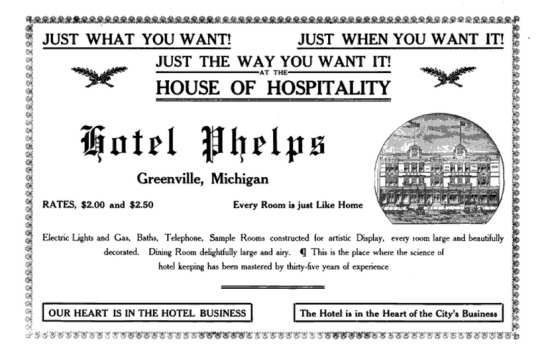
View On WordPress
#cemeteries#civil society#Civil War Era (1849-1865)#Gilded Age (1870-1900)#Greenville MI#Hannah C. Paddock#hotels#Josephine Jane Packard#laundress#multiple spouses#murder#Progressive Era (1896-1916)#social media#unmarried people
0 notes
Note
I can only send asks from my main blog I guess, but if you wanted to talk about this more: do you have any favourite historical eras you like to make art/design outfits for?
To preface this: „if you wanted to talk about this more.“
Yes. Literally the answer will always be yes I have a weekend headache‘s worth of information on this topic and how the gods of mankind‘s combined religions have held me back from bringing it up in every single conversation remains a mystery to me. Anyways:
Victorian and Edwardian periods, Western Aesthetics/Art/Dress/Whatever of the 1830s up through World War I if you’re talking in non-British-Exclusive terms lol. I’m only JUST starting to get into 1920s and 30s stuff and I’m not super interested in anything pre-1800s except a couple of art movements I really like the look of (Dutch Golden Age, Eastern Orthodox, etc.)
My sorta „specialty“ is the Gilded Age, so 1870s to 1900s America. I got into this literally right before Transitus was announced in 2020 and yes I 100% looked at the album and went „….ok yea it’s giving Northeast US aristocracy (very glittery and bright and obsessed with upholding appearances, unfathomably loaded with cash even by today‘s standards, post-civil war thinly veiled „slavery is bad yea but let’s not treat ‚em like actual human beings just yet“ racism, etc.) and we’ve just been riding that train ever since.
Worth mentioning my most prized possession is an annual collection of a Philadelphia homemaker’s magazine from 1883. Has the coolest visuals and most unhinged columns and recipes I’ve ever seen. I’m obsessed with it.
13 notes
·
View notes
Text
Gilded Age: Labor vs. Industrialization
Introduction:
During the Gilded Age, many have striven to prove that the industrialization and urbanization after the Civil War created unprecedented economic growth in the United States. Some have taken the stance that that this growth was made possible at the expense of the laboring classes’ standard of living. However, this conclusion is not totally accurate. While the amount of wealth of the United States did rise significantly (reported as “valuation of property” by the Department of Commerce), the standard of living in among the laboring classes also rose higher than ever. There was a correlation of the laboring classes’ advancement and the rise of the labor movement itself, however, it is unclear if one caused the other to occur or that the labor movement in the late 1800s had any effect at all on workers’ increase in wages or better working conditions overall. Some authors have noted that the consolidation of industry provided lower consumer prices, more efficiency in the supply chain and better financial opportunities for the creation of business itself. The labor movement had many things going against them in terms of an influx of immigration, a technological revolution, and periods of depression during this time.
Research:
In terms of measuring growth, one must look at the data that the US Census reported as an example of the relative expansion of property and manufacturing. From 1860 to 1880, the “valuation” of “property assessed for taxation” was used as a barometer of determining wealth in the US. Upon initial investigation, the total “wealth” of the United States almost doubled in the 10 years between 1860 and 1870 from a valuation of 16 billion to over 30 billion dollars. Using this methodology, the US gained another 1/3 of the 1870 value by 1880 with an estimated true value of over 43 billion dollars. The rise in manufacturing capital invested also followed a similar trend same trend over the same time period increasing from just over a billion dollars in capital invested in 1860 to over 2.7 billion invested by 1880.[1] Author Ballard C. Campbell noted that during the time period from 1870 to 1900 that the overall Gross National Product had almost tripled from 7.4 billion dollars to 18.7 billion dollars, with a large growth in manufacturing output.[2] This rapid growth of wealth might lead some to speculate that the benefits of such success could produce an overall level of material comfort and more spending power of consumers who would benefit from higher wages. However, historians point out that this growth in aggregate GNP did not necessarily correlate to a higher standard of living for all, but rather enriched a small population of industrialists and their managers.
Comparison of labor's gains with increase in standard of living:
Coinciding with this huge growth in GNP and property value, Mel van Elteren notes that the Gilded Age was “marked by steadily falling prices, economic recession and depressions, and a working class movement” that was exemplified with the rise of the Knights of Labor and the American Federation of Labor (AFL).[3] These labor unions were known to have some of their fastest growth during the post-bellum United States as they worked for higher wages and shorter work days. The AFL and other labor unions had steady growth in membership throughout the late 1800s having about 467,000 members by 1898 and garnering over 2 million by 1904 (the last real year of significant increase until the 1930s).[4] Likewise, the average workday between 1860 and 1890 decreased slightly by about an hour and wages increase by 50 to 60 percent.[5]
On the surface, the increase in overall monetary value and the “gains” of the labor movement seems to point to a direct correlation. However, upon further investigation, there could be other reasons for this success. As noted by Van Elteren, the labor movement produced the idea of “producerism” in which laborers thought that “the producer deserves the fruits of his or her labor, often expressed in biblical terms, such as ‘the laborer is worthy of his hire.’”[6] From this notion, labor unions expressed that the owners of the means of production were not being fair and that the laboring classes deserved a bigger part of the profits. However, Campbell noted that the American manufacturing sector had the upper hand in negotiations because there was a competition for American manufacturing goods, an drastic increase of cheap, immigrant labor, technological improvements that made some labor less important, advertising and retailing improvements and a decrease in shipping profits due to the consolidation of railroads (especially during recessionary times).[7] These factors were essential in providing for a decrease in the price of consumer goods, raw materials to make manufactured goods and adverting costs which was passed on to the public at large, thus making a larger contribution to the overall higher standard of living of all Americans during the later 19th and early 20th century. Overall, from 1871 to 1900 (1913=100 as a ‘base’ year) the Consumer Price Index dropped from 99 to 79, after a low of 71 in 1894 and 1896.[8] Life expectancy and GNP per capita also drastically increased between 1870 and 1900. The average life expectancy at birth was 42 in 1870 and by 1900 was 47 and the total average wealth produced by each person increased from $531 to $1,011 in the same period.[9] The results show that there was a significant improvement in overall quality of life.
Conclusion:
While it is still easy to recognize the huge income and lifestyle discrepancies of wealthy business owners and managers of the Gilded Age as compared to the rest of the United States, the age-old argument that business leaders only contributed to their own improvement is simplistic. As Niemi notes, the labor movement’s gains in the mid to late 1800s were “modest” compared to the gains in the early to mid-20th century.[10] The aggregate economic gains of the Gilded Age may not have been equally distributed, but they do show an overall improvement in the quality of life of most Americans, regardless of the labor movement itself.
[1] US Department of Commerce, Historical Statistics of the United States, 1789-1945: A Supplement to the Statistical Abstract of the United States, (Washington, DC: Bureau of Census, 1949), 12 https://www2.census.gov/prod2/statcomp/documents/HistoricalStatisticsoftheUnitedStates1789-1945.pdf.
[2] Ballard C. Campbell, "Understanding Economic Change in the Gilded Age," Magazine of
History, vol. 13, no. 4, (1999): 17. ProQuest.
[3] Mel van Elteren, "Workers' Control and the Struggles Against "Wage Slavery" in the Gilded
Age and After." The Journal of American Culture 26, no. 2 (2003): 188. https://go.openathens.net/redirector/liberty.edu?url=https://www.proquest.com/scholarly-journals/workers-control-struggles-against-wage-slavery/docview/200653423/se-2.
[4] Albert W. Niemi, Jr., US Economic History, (New York: Houghton Mifflin): 272.
[5] Ibid., 273.
[6] Mel Van Elteren, “Workers’ Control and the Struggles Against “Wage Slavery”…”, 189.
[7] Ballard C. Campbell, "Understanding Economic Change in the Gilded Age,” 17-18.
[8] US Department of Commerce, Historical Statistics of the United States, 1789-1945: A Supplement to the Statistical Abstract of the United States, 231.
[9] Ballard C. Campbell, “Understanding Economic Change in the Gilded Age,” 17.
[10] Albert W. Neimi, Jr., US Economic History, 273.
1 note
·
View note
Photo
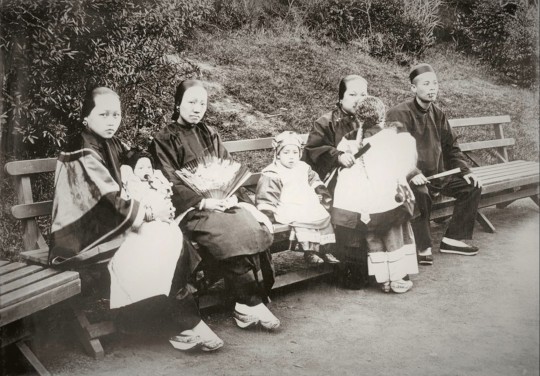
“Golden Gate Park. 1890s.” Photographer unknown (from the collection of the Bancroft Library).
Early Chinese Visitors in Golden Gate Park and Scenes From The Midwinter Fair
San Francisco’s Golden Gate Park represents the crown jewel of the city’s system of park and recreational spaces. Created on 1,013 acres of sand dunes in an unincorporated area of the Peninsula, known as the Outside Lands, and surveyor, designer, and future first Superintendent William Hammond Hall obtained the award of the project in 1870. Construction work commenced in 1871. The current acreage stands at 1,017 acres. (For a concise summary of the park’s creation and early photos by blogger “Doc B,” go here: https://thethirdself.com/2020/01/18/the-early-history-of-golden-gate-park/)
Since its inception, the life of Golden Gate Park even into this century has been marked by the tension between its founding as an urban public park for all and the impulse by segments of that public to allocate areas of the park for their specialized pursuits, uses, and monuments such as children’s playground, equestrian, archery, boating, museum, music, or lawn bowling. A subtitle for the history of the park could easily be posed as a question: “whose park?”
With a very few exceptions, the Gilded Age photos of the park’s patrons during its first 35 years of existence remain remarkable for their omission of at least 16 percent of San Francisco’s population – the Chinese. The photographic record is practically devoid of images of the City’s Chinese residents using the park.
As the above photo of a family in Golden Gate Park from the 1890s attests, the City’s first Chinese residents enjoyed the park. However, such daytime leisurely pursuits, which presumably included transportation to the western half of the City either by horse-drawn cart or cable car, would have been the privilege of a merchant’s household during the 19th century. The Bancroft collection’s striking photo captured not only a very rare instance of a Chinese family in the park but also the social standing of a fan-carrying, male head of household; he appears to have been accompanied by a young wife, probably his mother, and either a maid or an aunt of the three children shown in the photo.

“Chinese Women in Golden Gate Park, San Francisco, Feb. 22, 1900.” Photographer unknown (from opensfhisotry.org and courtesy of a private collector)
This photo of Chinese women, walking with fans on what may have been Golden Gate Park’s Main (now known as JFK) Drive, implicitly conveys the relative security of the unequal peace between whites and Chinese by the 1890s. By the start of the decade, the Chinese Exclusion Act of 1882 and a network of other laws and policies that reduced and compressed in urban enclaves most of the Chinese American population in California. The resulting smaller population, with its dwindling labor force, no longer posed a threat to white dominance of industry and trades on the urban frontier. Thus, even the “noble” women of Chinatown could travel to San Francisco’s Outside Lands and Golden Gate Park without fear of violence or other hindrance.
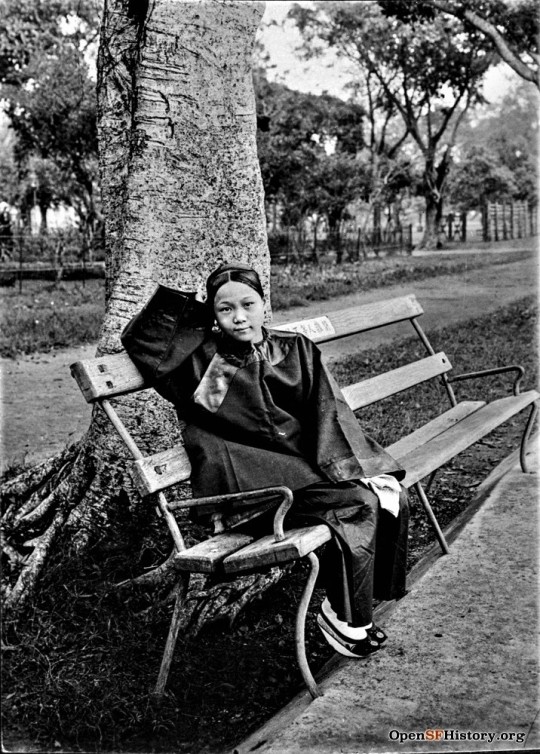
Chinese girl on a park bench, c. 1890s. Photographer and location unknown from the Marilyn Blaisdell collection.
The role of the Chinese in the first two decades’ history of Golden Gate Park, if any, remains unknown or at least unclear. Online resources only offer these few tantalizing images of San Francisco’s Chinese use of the park. Research continues.

A Chinese man walking toward three other Chinese in Golden Gate Park, c. 1900. Photographer unknown (from the Marilyn Blaisdell collection). The man is walking north between benches towards the old Memorial Museum and along the western side of the Music Concourse. The rear of the “Gladiator Statue” (of Spartan King Leonidas) by Willem Geefs appears at the center-left of the photo.
Chinese Go To The 1894 Midwinter Fair
The California Midwinter International Exposition of 1894, the first world’s fair held in the U.S. west of the Mississippi, offered 2 million visitors a glimpse of things to come in its 180 structures set on 160 acres. The Midwinter Fair, which was held in San Francisco’s Golden Gate Park from January 27 to July 4, 1894, used the grounds occupied the park’s area known today as the Music Concourse. Barbara Berglund’s fine and concise essay about this “Orientalist Exposition” envisioned by San Francisco Chronicle publisher Michael H. de Young may be read here.
From a Chinese American perspective, the Midwinter Fair provided the first significant grouping of photographs of Chinese participation in park activities and the opportunity presented by fair for the community to present a less-threatening image to the general public as embodied in the fair’s “Chinese Building.”

“8122 Chinese Building, Midwinter Fair, 1894. Photograph by Isaiah West Taber (from the Marilyn Blaisdell Collection). The Golden Gate Park’s powerhouse smokestacks appear at left.
Berglund quotes contemporary observations about the building as follows:
“The Chinese Building, designed by a local architectural firm and financed by the city’s Chinese merchants allowed visitors to view and possibly purchase ‘the deft handiwork of Chinese artisans and the wonderful products of Chinese ingenuity’ and provided ‘a curious and instructive object-lesson of the architectural ability of the inhabitants of the great Empire of the East.’”
Although not apparent at the time, the merchant community’s commission to a white architectural firm foreshadowed the strategy that Chinese merchants would use to rebuild Chinatown after the disaster of 1906. Taking a cue from the Midwinter Fair, Chinatown would be reconstructed into the tourist-serving “Oriental City” which would serve as the architectural economic template for diaspora communities around North America and beyond. Berglund correctly perceived the following promotional benefits of Chinese participation in the Midwinter Fair.”
“But the positive associations that could be derived from the Chinese Building about the achievements of Chinese culture were tempered by negative associations with Chinatown. Since the Chinese Building contained a restaurant, tea house, joss house, theater, and bazaar it not only replicated many of the standard sites of Chinatown’s tourist terrain but also the racializing work done by them. The fair’s promotional literature even told visitors that all of the ‘attractive features’ of Chinatown could be seen at the exposition’s Chinese Village ‘under much pleasanter conditions’—thus playing on prevailing stereotypes of the neighborhood as filthy, malodorous, and teeming and conjuring up unfavorable images of Chinese immigrants willing to live in such an environment.’”
As for the Chinese community itself, Berglund writes as follows:
“On the day that the Chinese Building opened, a Chronicle report related, “The Chinese themselves took a huge interest in the exhibit and the place was thronged all day.” This account noted that the merchants and tourist entrepreneurs “in charge” were “mightily proud of their building.” They “conducted visitors to the joss house,” while in the “reception room” a “cultured Chinese … explained the hidden meaning of the wondrous works of art which adorned the walls.” These men aided and abetted the Midwinter Fair’s Orientalist fantasy by presenting an image of the Orient that, to non-Asian visitors, likely came across as reinforcing the difference, strangeness, and barbarism of people of Asian descent. However they also created a space that San Francisco’s Chinese could participate in and succeeded in representing Chinese culture in ways that this local community could respond to with enthusiasm and pride.”
This more subtle civic engagement agenda, whether intentional or subconscious, can be seen in the some of the photographs of Chinese participants at the fair, particularly in the juxtaposition of the US flag with Chinese imagery as in this photo of a horse-drawn float with a dragon prow.

Golden Gate Park. China Day at the Midwinter Fair Jun 1894
A large dragon boat float in Chinese motif, flying American flags and pulled by horses. (Photographer unknown from the Wyland Stanley Collection)

“8484 Chinese Day at Midwinter Fair” June 1894. Photograph by Isaiah West Taber (from the Marilyn Blaisdell Collection). Children from San Francisco’s Chinese Public School form up in Golden Gate Park for China Day at the 1894 Midwinter Fair.

Children from San Francisco’s Chinese Public School line up in Golden Gate Park for China Day at the 1894 Midwinter Fair. Photographer unknown (from the collection of the San Francisco Public Library).
The deployment of Chinese children from Chinatown in citywide events served the new, benign narrative. The student-participants from the segregated Chinese Public School carried American flags conveyed patriotic sentiments and also a sense of poignancy. By 1894, the exclusion of Chinese from the US had been made permanent with the Geary Act of 1892, and the Chinese Six Companies-led boycott of the federal law’s residency certificate scheme had collapsed miserably in the preceding year after the US Supreme Court’s decision in Fong Yue Ting v. United States, 149 US 698 (1893).
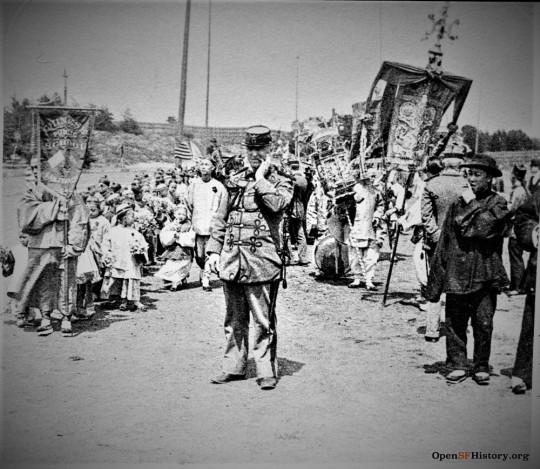
"9605. Chinese Children, Midwinter Exposition” 1894. From the Jas. A. Davis Kilburn catalog. Photograph by B.W. Kilburn (from the Marilyn Blaisdell Collection). Children from the Chinese Public School prepare to march in the China Day parade at the Midwinter Fair.
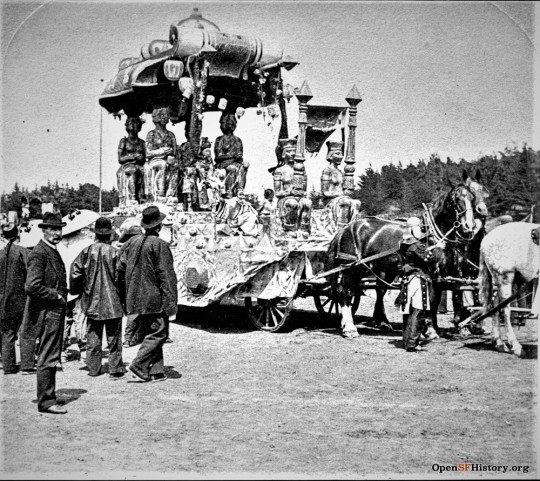
Chinese parade float pulled by a team of horses at the Midwinter Fair of 1894 in Golden Gate Park. Published in the Jas. A. Davis Kilburn catalog: "9615 Sacred Gods of China. Arranged on a float for the inspection of visitors." Photograph by B.W. Kilburn (from the Marilyn Blaisdell Collection).
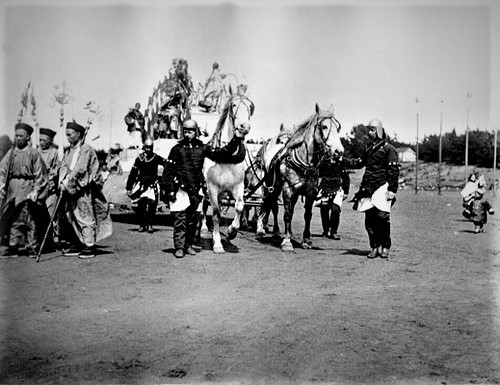
China Day parade at the 1894 Midwinter Fair.


Boys and banners float for Chinese parade on Recreation Field (Big Rec) for the Midwinter Fair, June 1894. Photographer Unknown (from the Wyland Stanley Collection).
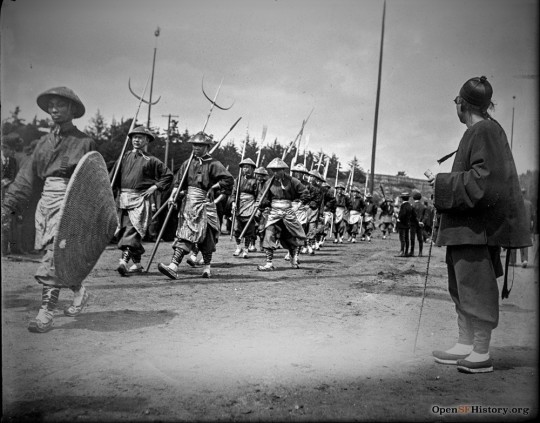
Marching men in costume/uniform with shield and tridents at the Midwinter Fair of 1894. Photographer unknown (from the Wyland Stanley Collection).
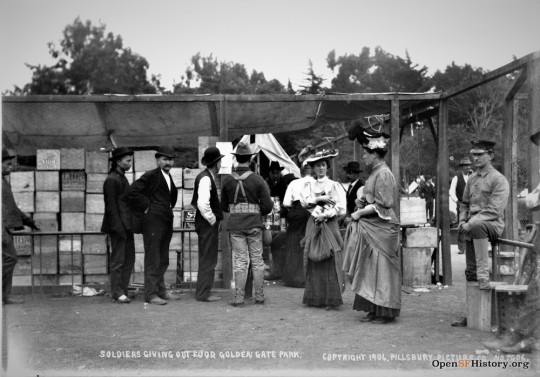
“Soldiers Giving Out Food, Golden Gate Park,” 1906. Pillsbury Picture Co. No. 7606, Pillsbury Picture Co. (from a private collection). Two Chinese men join a relief line overseen by federal trooper. Such proximity to whites in Golden Gate Park would not last long, as the Army would relocate the Chinese to the Presidio encampments after white protests.

Earthquake refugees being fed in the park, May 1906 Photographer Unknown (courtesy of a private collector). Some of the diners appear to wear Chinese dress of that era, but their presence cannot be ascertained definitively.
The presence of Chinese earthquake refugees in Golden Gate Park was short-lived. White refugees and neighbors demanded that the US Army move the Chinese refugees from Golden Gate Park and the main camp at the Presidio’s golf course. The Army complied and moved the Chinese to Fort Winfield Scott.
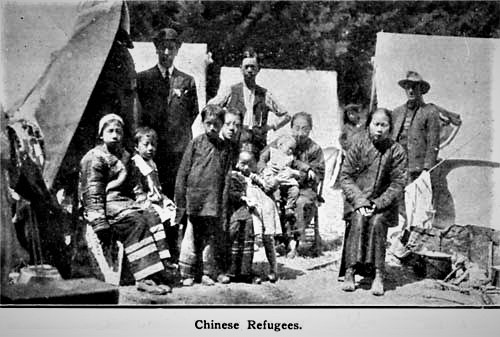
“Chinese Refugees” c. April 1906. Photographer unknown
The photographic record of Chinese community patronage of Golden Gate Park remains scant, even in the hundreds of photo taken of the mass refugee evacuation and temporary resettlement to the park in the aftermath of the 1906 quake and fire. Military inspection reports indicate that the Army provided for the Chinese and all of the other refugees in the Presidio. However, the Chinese are largely absent from the contemporary photos taken of the bread lines, the large tent encampments, and other refugee sites in Golden Gate Park. Segregation of the community prevailed even in the midst of disaster.
Research continues.
#Chinese visitors to Golden Gate Park#1894 Midwinter Fair#Midwinter Faire of 1894#Chinese Public School#Chinese refugees of 1906#Isaiah West Taber#B.W. Kilburn
0 notes
Text
MET GALA 2022 - 4
MET GALA 2022 – 4
Hola, chic@s!!
El pasado 2 de mayo se celebró en el MET de New York, la gala anual de la moda.
La temática de éste año titulada “In America: An Anthology of Fashion”, estaba dedicada a la Gilded Age, la época entre 1870 y 1900.
No todas las invitadas estuvieron inspiradas, ni acertadas en la temática (que vendrían a ser muchos bustiers, mangas abullonadas y faldas con volumen en la parte…

View On WordPress
0 notes
Text
5 fatos estranhos e absurdos a respeito da Era Dourada
5 fatos estranhos e absurdos a respeito da Era Dourada
Era Dourada, ou "The Gilded Age", foi como ficou conhecido o período final do século XIX nos Estados Unidos, que se estende da década de 1870 até próximo do ano 1900. Ganhou este nome por conta de um romance de Mark Twain, em que o autor satirizava problemas sociais que marcaram o período.
Neste recorte de época, a sociedade norte-americana viu surgir a classe dos ultra-ricos, em meio a muito…

View On WordPress
0 notes
Text








Photographs of George Edward Anderson (1860-1928), American Mormon photographer.
Pictures taken between the 1880's and 1910's.
#19th century#19th century fashion#19th century photography#history#victorian era#history geek#history nerd#old photography#victorian fashion#victorian photography#1870s#1880s#1890s#1900s#1910s#gilded age#antique#antique portrait#antique photography#edwardian era#us history#old photograph#fashion history#late 19th century#history lover#history crushes#history crush#victorian boyfriend#victorian#edwardian boyfriend
46 notes
·
View notes
Text
Nothing is more of a slap in the face with stupidity than coming on here morning after the Met like you guys. That’s not a gilded age corset that’s an Elizabethan corset, also not a gilded age corset that’s a Tudor corset. That’s not a gilded age silhouette it’s a panniered dress, gilded age women wore bustles. Also no feathers were not used on anything but hats, sorry. Nope, that’s regency style neckline, not gilded, as it has too much cleavage. Gilded age formalwear had high necklines and collars. Also, I hate to break it to you, but that’s a tuxedo not a suit and a mens tuxedo is extremely on theme because it first became popular in America in the gilded age. So yes, it’s 100% on the money.
#also it’s a charity for the costume institute but not a costume ball so#no you’re not supposed to show up in a house of worth dress#i was all around pretty impressed tho a lot of historical accuracy last night!!#gilded age is an easy theme tho#too many people took it for simply gold which like…. I mean…. not in clothing in interiors and economic growth#but fine I’ll give it a pass cuz you’re supposed to interpret the theme not imitate it outright#so if you chose to interpret the rising economic disparity element I salute you!#also gilded age doesn’t = Victorian era!!#Victorian spanned most of the 1800s and was in England#gilded age was america specific and post civil war so 1870-1900#read a BOOOK
14 notes
·
View notes
Text
The Latest From Atelier Lily Absinthe - Gilded Age Sale!!!
The Latest From Atelier Lily Absinthe – Gilded Age Sale!!!
Announcing another Gilded Age sale at Atelier Lily Absinthe!!! Select Gilded Age Era (1870-1900) sewing patterns are on sale for 15% off. Check it out!
Become a Patron!

View On WordPress
#1870s#1880s#1890s#Atelier Lily Absinthe#Lily Absinthe Gowns and Corsetry#Mid Bustle Era#Natural Form Era
1 note
·
View note
Text
Book Rec: Food in the Gilded Age: What Ordinary Americans Ate, by Robert Dirks
Brief Description: A really interesting read about the cooking and eating habits of people of limited means during the Gilded Age. The book is broken into six chapters: 1. Nutrition History, 2. Mountaineers and the Nutrition Transition in Appalachia, 3. African Americans and Soul Foods, 4. Rich and Poor and the Seasonality of Diet, 5. Immigrants’ Diets, and 6. Contrasts.
Excerpt: “Forman did not subscribe to the popular doctrine that the poor needed to be taught how to spend their food dollars wisely. To the contrary, he saw his subjects as astutely rational. If they ate mostly bread, spending as much as 25 percent of their food dollars at the baker’s shop, it was because at five cents a loaf there was no better nutritional bargain (except for stale loaves, which were available at four cents and less). The cost of oven fuel alone banished any thought of home-cooked bread or rolls. Time was also a consideration. If oatmeal was not on the menu for breakfast, it was not because parents were careless, but rather because harried homemakers in poverty-stricken households could ill afford time in the morning to prepare a hot breakfast. [...] When push came to shove, the first foods pared from shopping lists were fruits and vegetables other than potatoes” (pg. 81).
#now if only some ppl today could grasp as well as this dude from c. 1900 that poor ppl do in fact generally know what they're doing#'bad' food decisions by poor ppl are generally made b/c those are their best options---not because they're stupid#food history#social history#gilded age#US history#american history#History!#20th century history#19th century history#1900s history#1900s#1870s#1880s#1890s#1890s history#1880s history#1870s history#19th century#20th century#the more you know#history#food#book recs#book recommendations#phos recs
17 notes
·
View notes
Text
Gilded Glamour
The theme of this year's Met Gala and accompanying exhibition is 'In America: An Anthology of Fashion' which apparently means they are taking inspiration from the Gilded Age (∼1870-1900) in the United States. According to the invitations, the dress code is 'gilded glamour, white tie.' We usually see at least a couple of tiaras at the Met Gala but this year I'm hoping for a lot of them!
Tiaras were very popular for wealthy women in the Gilded Age which I love because most people think that tiaras are just for royalty and that is not true at all. The trouble is that non-royal tiaras are so much more difficult to find information about than their royal counterparts and I'm always on a mission for info about American tiaras. Here's a few Gilded Age tiaras to get us exited!
Mary-Louise Hungerford MacKay’s Trefoil Arabesque Tiara by Boucheron, 1889
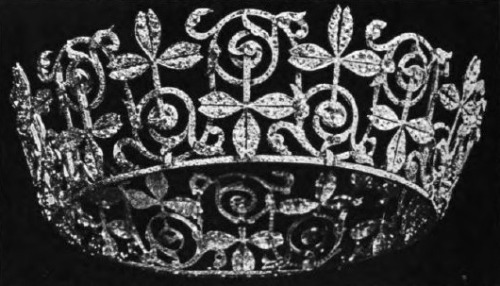
Alva Smith Vanderbilt's Pearl Tiara by Boucheron, 1890

Julia Kemp's Diamond Tiara by Tiffany & Co., 1894

Gertrude Vanderbilt Whitney's Diamond Tiara by Boucheron, 1896

Cornelia Sherman Martin’s Diamond Flame Tiara, before 1897
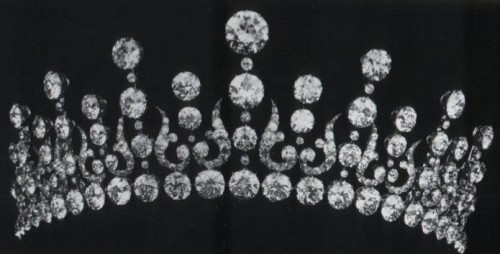
JP Morgan's Diamond Winged Tiara by Cartier, 1901 (I'm assuming he bought this for someone else and wasn't just wearing it around the house but you never know)
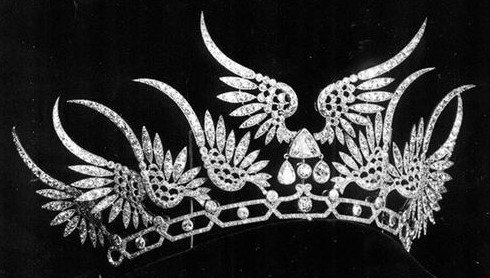
Lila Vanderbilt Sloane Field's Diamond Tiara by Cartier, 1902
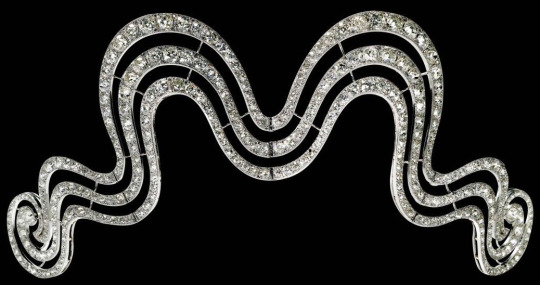
Mary Morgan Burn's Ruby Tiara by Boucheron, 1903
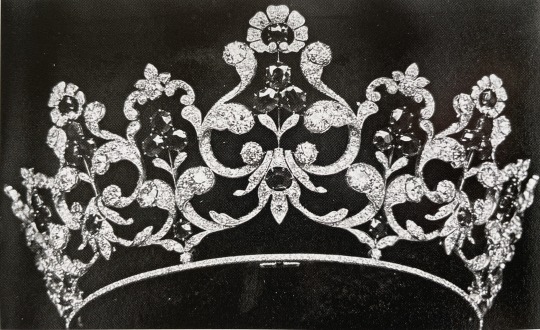
Harry Payne Whitney's Wreath Tiara by Cartier (I assume he bought this for his wife, Gertrude Vanderbilt Whitney, but his sister-in-law, Gladys Vanderbilt Széchenyi, was photographed wearing a very similar tiara in all diamonds)
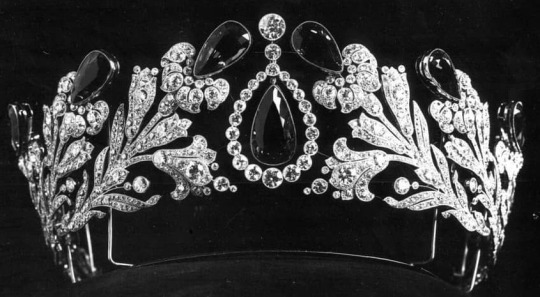
Mary Scott Townsend's Diamond Tiara by Cartier, 1905
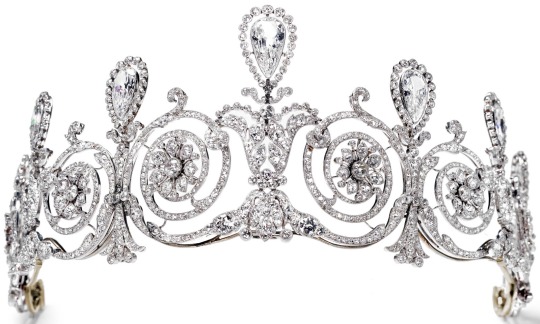
#Met Gala#Tiara Talk#tiara#United States#Tiffany#Cartier#Boucheron#Gilded Age#I'm prepared to be disappointed by no one following the theme
2K notes
·
View notes
Text
gilded age, eh?
The Gilded Age, as it was called, was a period from 1870-1900 that saw unprecedented American economic and technological growth. It saw a new class of wealth come to American society: the industrialist. It was an era where grandiose displays of wealth became fashionable in a way that hadn't been seen since the days of Versailles.
All of this wealth, of course, came from the brutal exploitation of the working poor. This is also the era from which socialism was born.
A gilded object is covered in a thin layer of gold, but is made of cheap materials on the inside. This is the true nature of the era: an outside allure of glamor and glitter, but was built on a rotten core.

2K notes
·
View notes
Text
Met Gala 2022
So Met Gala was in the middle of the night for me (started around 2 am my time), which is why I'm giving my thought on the outfits now. I'm not interested in celebrity fashion and not very interested in contemporary fashion in general, but since it was Gilded Glamour themed, I was curious to see what they came up with. Gilded Age or the Late Victorian Era, 1870-1900, but in US, is one of my favorite fashion periods.
I'll be judging how well they adapted the theme, how interesting take they have on it and how pretty it looks like in my opinion. As expected it was overall pretty disappointing. So so many are way of theme, some just clearly skipped it entirely.
I'll do highlights, there's too many to comment everything individually. I'll start with my favorites, but in no particular order and it'll be just downhill from there.


This outfit is so goddamn stunning. Firstly undergarment look is always excellent choice. Then the silhouette is impeccable 1880s second bustle era silhouette. I love that it's in soft colors, reminding of mostly white undergarments. The hair is also perfect, clearly 1880s inspired, but a little more punk-like, which is a great touch. Necklace also is perfect and references the highly fashionable black silk chokers of the time. It's also a very nice and sharp contrast to the dress.


I absolutely adore the dressing gown. It's very clearly referencing tea gowns that became by the 1890s very fashionable and more casual reception dresses. The burgundy red velvet is gorgeous and I adore the long sleeves. Unfortunately the jumpsuit under it is just ugly. It's fine when she has the dressing gown, but damn it looks terrible alone. I actually kinda like how it's texture contrasts with the velvet.
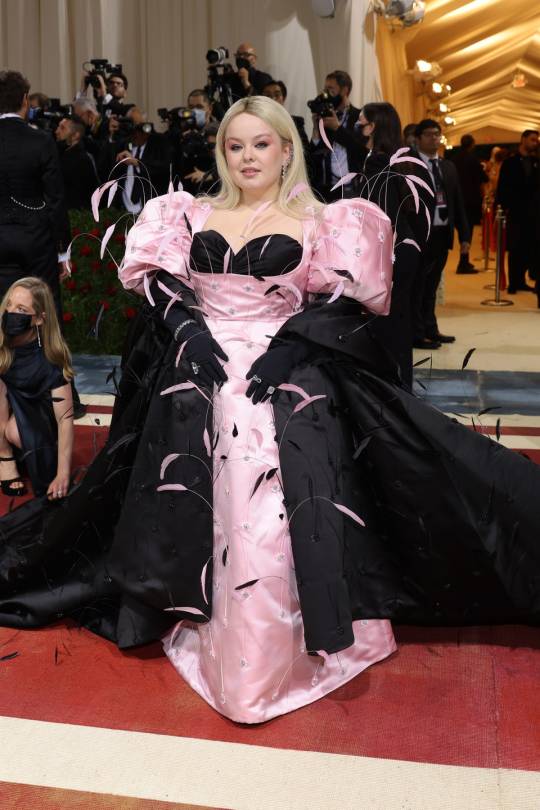

This is one proper 1890s inspired gown. The silhouette is basically perfect. The fabric is gorgeous. Thick silk satin gives the dress enough body and substance. I love the contrasting soft pink and harsh black. The cape thing with the dramatic trail really tops it. I actually like the weirdly applied feathers. I think they make it fun. My complaint is that feathers weren't a fashion item at the time. I also love her makeup, it fits perfectly with the outfit, but the hair is fairly disappointing.
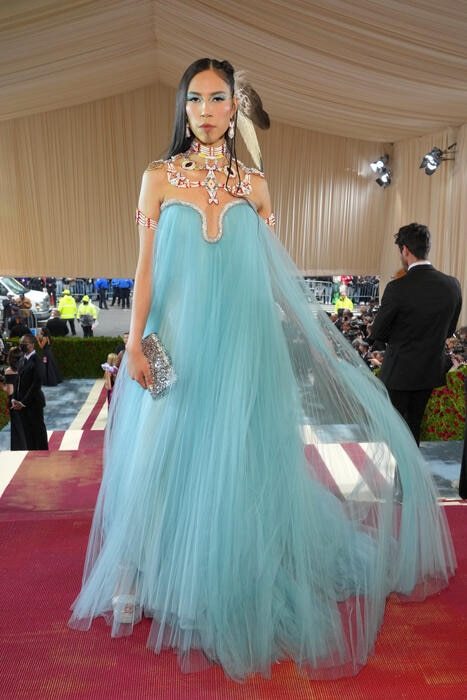
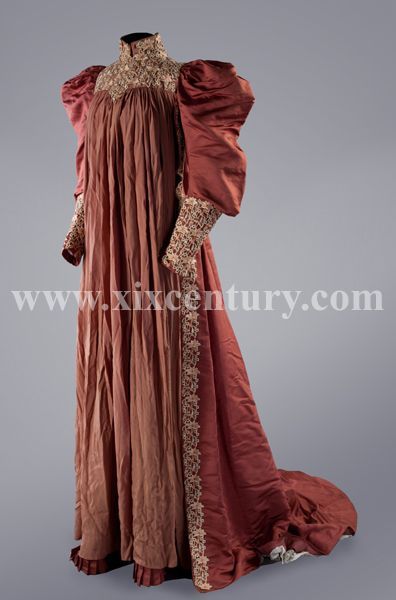
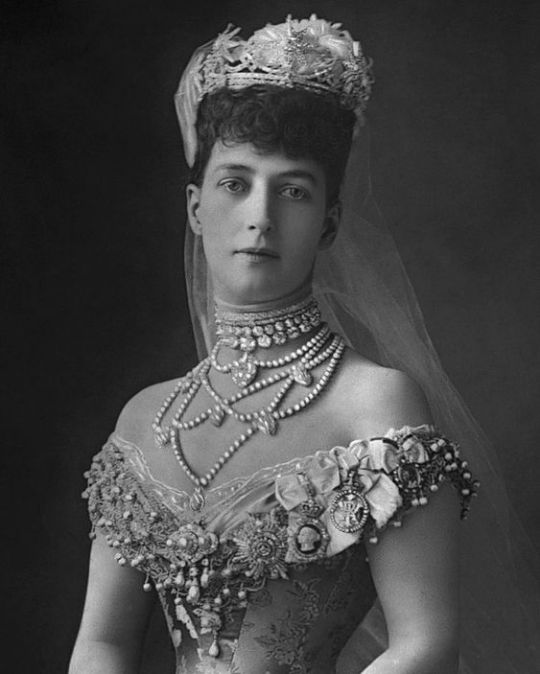
Quannah Chasinghorse is serving the looks yet again! She is absolutely gorgeous. The light turquoise really fits her. In an interview she told, she designed her jewelry with Native jewelry makers, who made them from traditional natural materials. I saw some people say she wasn't on theme and other's she shouldn't be expected to be on theme, when it's colonizer fashion glamour, and I agree with the latter point. I do think she was on theme though. I think her necklace references in shape the elaborate late Victorian chockers royalty would use and her dress references tea gowns, especially the Aesthetic kind. Tea gowns emerged from Aesthetic dress, a counter culture Victorian fashion, and became mainstream in 1890s. But Aesthetic movement, while some of it's styles were popularized in mainstream, was still going strong in 1890s. Their dresses were often flowy and rejected the highly structured and fitted silhouette.
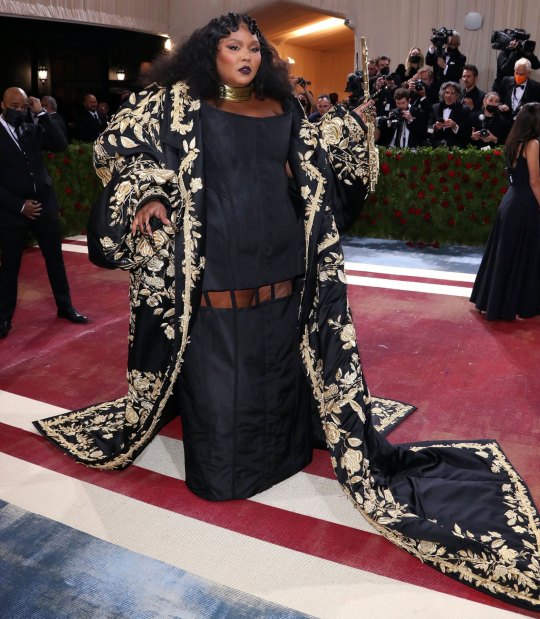
I adore this cloak!! The embroidery is gorgeous, it's big, dramatic and the SLEEVES! The sleeves have drama! It's just perfect. It's heavy enough so it moves and drapes beautifully. Exactly this type of nature themed embroidery is very popular in 1890s gowns. I'm a little unsure of the dress though. I like that it's structure, but it has a bit more Baroque style than Victorian. Also the cut in the middle makes it look a little weird to me. Her necklace and styling are on point though. I like her open natural hair with the dressing gown type cloak and I like the detail of the shaped hair on top, even if it's very 1910s and very much out of Gilded Age.
Since the image limit is what it is, I'll continue with more of my faves in a reblog. The full post is here.
#met gala#met gala 2022#fashion history#historical costuming#fashion#gilded age#historical fashion#victorian era#victorian fashion#gilded age fashion#costuming#history bounding
746 notes
·
View notes
Text
MET GALA 2022 - 3
MET GALA 2022 – 3
Hola, chic@s!!
El pasado 2 de mayo se celebró en el MET de New York, la gala anual de la moda.
La temática de éste año titulada “In America: An Anthology of Fashion”, estaba dedicada a la Gilded Age, la época entre 1870 y 1900.
No todas las invitadas estuvieron inspiradas, ni acertadas en la temática (que vendrían a ser muchos bustiers, mangas abullonadas y faldas con volumen en la parte…

View On WordPress
#2022#alarcobyalba#designers#diseñadores#elegance#fashionblog#featured#glamour#met#metgala2022#Moda#newyork#redcarpet
0 notes
Text
Met Gala 2022 Thoughts
Am I really talking about the 2022 Met Gala already? It still feels like a few weeks ago we were all rolling our eyes at how badly the fashion was because attendee’s either couldn’t be bothered or didn’t understand the theme. Overall it was so underwhelming that I had no idea this year’s gala was back to it’s usual May slot and less than six months after the borefest of 2021. Anyway here we are judging everyone who was lucky enough to attend the prestigious gala.
This year’s theme was “Gilded Glamour” which in my opinion is one of the easiest themes to ever be announced by the Met Gala. It’s also about The Gilded Age which was the period of history between 1870 and 1900 when the United States saw massive economic growth and rapid industrialisation. So did I see many gold or gowns that were inspired by this period in history? No. Was the fashion better than 2021? Absolutely.
Here are my favourites that I felt followed the theme as closely as possible and just looked amazing and made up for the shitshow of 2021.
Blake Lively (look one & look 2)
Once again Blake came to the Met Gala and she slayed it at the Met Gala with one of the most eye catching and gorgeous gowns of the entire night. It was by Versace (again) and was apparently inspired by the skyscrapers of New York City and the Statue of Liberty. Also what better way for Blake to make her grand return to the Met Gala with a two in one gown, all in all this look was EVERYTHING! 😍
Kim Kardashian
I know this look gained a lot of online controversy because she wore an original Marilyn Monroe gown that many believed she had no right to wear etc. However I thought she looked gorgeous in it, it was simple but still elegant and let’s face Marilyn Monroe was a fashion icon for her time and that should be celebrated. Plus it was nice to see that Kim had broken the curse of her dementor look from 2021 and decided to wear something a bit more normal in terms of high end fashion.
Billie Eilish
This look really surprised me as I’m not a fan of Billie Eilish and her fashion choices at all, plus I didn’t like the nude gown she wore at the 2021 Met Gala (it clashed with her skin tone and made her look ill). But if anyone understood the theme this year it was Billie and she looked amazing in her custom Gucci gown. She really looked like she had stepped out of a painting from the Gilded Age, I don’t think I have anything more to say other than bravo Billie, bravo! 👏🏻
Katy Perry
Hallelujah! Katy didn't dress as either chandelier or a cheeseburger at this year’s Met and instead went for a classic Oscar de la Renta gown instead. What I loved about this gown is that Katy Perry posted a photo on Instagram of a classic oil painting that was clearly the inspiration behind her look. Also the back of the gown embodied the gilded age with a black silk taffeta skirt that ruffled up around the derrière.
Laura Harrier
This might be my second favourite gown (after Blake) because I love black, I love silver and I love sparkle which was all rolled into one in Lauren’s H&M custom gown. Also I loved the subtle damask pattern on the gown to give it that deep rich look that just made it feel that bit more of a period piece but with a modern twist to it. It was understated but it was beautiful and huge props to Laura for going with H&M instead of haute couture designer.
Cardi B
I can’t believe I’m actually mentioning Cardi B as just like Billie Eilish I’m not a fan of her whatsoever, but she did wear a stunning Atelier Versace gown that I can’t take my eyes off anytime I see it online. It gave me elegant steam punk vibes which I love outside of high end fashion and the fact that she understood the gilded portion of the theme was enough for me to fall in love with her look.
Sarah Jessica Parker
She plays a style icon and she slays as a style icon once again the Met Gala. I loved this gown by Christopher John Rogers because it was so unusual yet so fitting for the theme all at the same time. It won me over just for being unique. According to Vogue Sarah paid homage to Elizabeth Hobbs Keckley, who made history as the first Black female fashion designer in the White House. You can read more about Sarah’s gorgeous look and the inspiration behind it here.
Anitta
I don’t know much if anything about Anitta but her look caught my instantly this morning whilst I was browsing the Met Gala hashtag on Twitter. I thought she looked breathtaking in the deep purple duchess satin Moschino gown. Everything about the gown was both stunning and elegant and I loved the pearls that really finished off the look and just screamed royalty in the gilded age. 💜
So yeah thats my favourite looks from this years Met Gala, it was definitely fun to look through them all this morning in comparison to last year. Heck even some of the male attendee’s went all out this year even if some didn’t follow theme (like Sebastian Stan wearing Valentino 😍). Like I said before though clearly some attendee’s understood this years theme (and knocked it out the park) whilst others ignored it in favour of their own taste in high end fashion instead. Personally I think those that attend the Met Gala and ignore the theme entirely should be banned from attending future events.
Anyway feel free to leave a comment or drop me a message letting me know your thoughts on this year’s Met Gala. Did you have a favourite look? Was the theme better than 2021 and do you think it’s okay for attendee’s to ignore the theme entirely?
#Personal#Met Gala 2022#Blake Lively#Kim Kardashian#Billie Eilish#Katy Perry#Laura Harrier#Cardi B#Sarah Jessica Parker#Anitta
718 notes
·
View notes